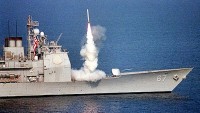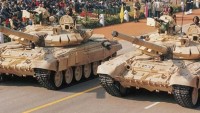Russia’s Su-35S Fighter a Big Failure in Ground Attack Missions in Syria
| Arthur Dominic Villasanta | | Jun 06, 2017 07:06 PM EDT |
(Photo : Russian Air Force) Su-35S.
The Sukhoi Su-35S supermaneuverable multirole fighter in service with the Russian Air Force is optimized for air-to-air combat but is quite useless as a ground attack aircraft as proven by its combat experience in Syria.
Russian state-controlled media reports the air force as being "more or less satisfied with the Su-35S" and its performance in Syria.
Like Us on Facebook
The "less" in this case is the result of the failure of the fighter's PESA (Passive Electronically Scanned Array) radar to accurately and consistently locate and guide bombs onto their targets.
"Since the aircraft was employed for ground strike missions -- more with smart weapons and dumb bombs -- there can be some modifications for software and systems responsible for ground attack," said Vassily Kashin Ph.D., a senior research fellow at the Center for Comprehensive European and International Studies at the National Research University-Higher School of Economics.
Kashin also said "there were just some small problems (with the Su-35S), which emerged during the intense combat use during the war."
The obvious solution to the problems generated by PESA is to upgrade the Su-35S' radar system to the newer and more sophisticated active electronically scanned array (AESA) radar.
The Russian Air Force, however, has no immediate plans to upgrade the Su-35S with major new systems like an active electronically scanned array (AESA) radar.
"There will be no AESA," said Kashin.
He said the Su-35S already has "a very powerful PESA radar and it is considered to be the strong point."
He noted that what the Su-35S and the Russian Air Force for ground attack missions are targeting pods similar to the Lockheed Martin Sniper or Northrop Grumman LITENING pods, but Russia apparently has no interest in developing advanced versions of these devices.
The Su-30SM and the Su-35 have to rely on their PESA radars for targeting air-to-surface targets because they lack targeting pods.
"The lack of pods is considered to be a major weakness of the Russian Air Force," said Kashin.
"There is a targeting pod development program which started even before Syria, but no results yet."
TagsSukhoi Su-35S, Russia, Syria, PESA, Passive Electronically Scanned Array, Radar, Vassily Kashin, Active Electronically Scanned Array, AESA
©2015 Chinatopix All rights reserved. Do not reproduce without permission
EDITOR'S PICKS
-

Did the Trump administration just announce plans for a trade war with ‘hostile’ China and Russia?
-

US Senate passes Taiwan travel bill slammed by China
-

As Yan Sihong’s family grieves, here are other Chinese students who went missing abroad. Some have never been found
-

Beijing blasts Western critics who ‘smear China’ with the term sharp power
-

China Envoy Seeks to Defuse Tensions With U.S. as a Trade War Brews
-

Singapore's Deputy PM Provides Bitcoin Vote of Confidence Amid China's Blanket Bans
-

China warns investors over risks in overseas virtual currency trading
-

Chinese government most trustworthy: survey
-

Kashima Antlers On Course For Back-To-Back Titles
MOST POPULAR
LATEST NEWS
Zhou Yongkang: China's Former Security Chief Sentenced to Life in Prison

China's former Chief of the Ministry of Public Security, Zhou Yongkang, has been given a life sentence after he was found guilty of abusing his office, bribery and deliberately ... Full Article
TRENDING STORY

China Pork Prices Expected to Stabilize As The Supplies Recover

Elephone P9000 Smartphone is now on Sale on Amazon India

There's a Big Chance Cliffhangers Won't Still Be Resolved When Grey's Anatomy Season 13 Returns

Supreme Court Ruled on Samsung vs Apple Dispute for Patent Infringement

Microsoft Surface Pro 5 Rumors and Release Date: What is the Latest?













